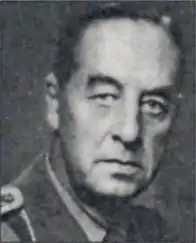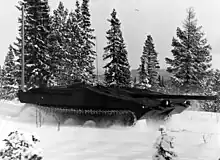Edward Malm
Lieutenant General Edvard (Edward) Magnus Samuel Malm (20 August 1899 – 23 May 1983) was a senior Swedish Army officer. Malm served as commander of Stockholm Anti-Aircraft Regiment (1949–1956), as Deputy Chief of Ordnance (1956–1959), and as Master-General of the Ordnance (1959–1964).
Edward Malm | |
|---|---|
 | |
| Birth name | Edvard Magnus Samuel Malm |
| Born | 20 August 1899 Bäve, Sweden |
| Died | 23 May 1983 (aged 83) Salem, Sweden |
| Allegiance | Sweden |
| Service/ | Swedish Army |
| Years of service | 1921–1964 |
| Rank | Lieutenant General |
| Commands held | Stockholm Anti-Aircraft Regiment Deputy Chief of Ordnance Master-General of the Ordnance |
Early life
Malm was born on 20 August 1899 in Bäve Parish, Gothenburg and Bohus County, Sweden,[1] the son of Thomasine Ulrika Barnekow and the Minister for War (1907–1911), lieutenant general Olof Malm.[2] Malm passed studentexamen in 1918.[3]
Career
Malm graduated from Military Academy Karlberg in 1921 and was commissioned as an officer and assigned as a second lieutenant to Svea Artillery Regiment the same year, where he was promoted to lieutenant in 1925.[4] He attended the General Artillery Course at the Artillery and Engineering College from 1922 to 1923[5] and the Higher Artillery Course there from 1924 to 1926.[5] He served in the Artillery Staff from 1927 to 1928 and in Svea Artillery Regiment from 1928 to 1930 and took a course for weapons officers in 1930 and received air defence training.[3] From 1931 to 1933 Malm studied at the Royal Institute of Technology in Stockholm.[2] He then served in the Royal Swedish Army Materiel Administration between 1933 and 1943: as a control officer at the Control Department (Kontrollavdelningen) in the Military Office (Militärbyrån) in the Artillery Department (Artilleridepartementet) from 1933 to 1936, in the Artillery Gun and Instrumentation Department (Pjäs- och instrumentavdelningen) in the 1st Materiel Office (1. materielbyrån) in the Ordnance Department (Tygdepartementet) from 1936 to 1940, as head of and rapporteur in the Industry Office (Industribyrån) in the Ordnance Department from 1940 to 1941 and as head of the Maintenance Office (Underhållsbyrån) in the Ordnance Department from 1941 to 1943. Malm was promoted to captain in 1935 and transferred to the Swedish Army Ordnance Corps in 1936. He attended an ordnance officer course in 1940 and was promoted to major in 1941. In 1943 he was promoted to lieutenant colonel, after which he served in Östgöta Anti-Aircraft Regiment from 1943 to 1945. He served from 1945 to 1948 in the Anti-Aircraft Department (Luftvärnsavdelningen) in the Army Inspectorate (Arméinspektionen) in the Army Staff, whereupon from 1948 to 1949 Malm was an assistant at the Weapons Office (Vapenbyrån) in the Ordnance Department (Tygavdelningen) of the Royal Swedish Army Materiel Administration.[3]
In 1949 he was promoted to colonel, after which he was commander of Stockholm Anti-Aircraft Regiment from 1949 to 1956 and studied at the Swedish National Defence College in 1955.[6] He then served as Deputy Chief of Ordnance in the Royal Swedish Army Ordnance Administration from 1956 to 1959. He was promoted to major general in 1959, whereupon Malm served as Master-General of the Ordnance and head of the Swedish Army Ordnance Corps from 1959 to 1964. He was vice chief of the Royal Swedish Army Ordnance Administration from 1959 to 1963 and head of the same authority from 1963 to 1964.[4] As vice chief and head of the Royal Swedish Army Ordnance Administration he was a member of the Administration Board of the Swedish Armed Forces from 1959 to 1964.[7][8] He was a member of the board of the Swedish National Defence Research Institute from 1957 to 1964 and chairman of the Central Joint Consultation Board of the Swedish Armed Forces (Försvarets centrala företagsnämnd) from 1960 to 1964.[3] Malm retired from active service in 1964 and was promoted to lieutenant general on the reserve list.[4]

“As the newly appointed Master-General of the Ordnance, Edward Malm was faced with procurement tasks that were both technically and financially more extensive than those his predecessors had to solve. This extensive procurement activity had been prompted by the Defence Act of 1958, that the Army's equipment would soon be significantly strengthened with weapon systems, which a potential attacker would not be able to easily destroy with the help of tactical nuclear weapons. Among other things, it was a matter of developing combat vehicles of new kinds, mainly a new tank, an armored, self-propelled, long-range artillery gun and a new, relatively well-armed vehicle for armoured infantry. Malm was well grown for the big tasks. His powerful figure proved to be matched by an ability to work and a courage to make difficult decisions, which went far beyond the ordinary. Purposefully, he expanded his knowledge in the relevant technology areas. As for the previously mentioned new combat vehicles, for which he was given responsibility, he was not satisfied with the knowledge and experience that was available within Sweden. More than any of his predecessors, he took the time to study developments elsewhere and to discuss important problems with foreign expertise on his own. Edward Malm personally took a very active part in the decisive negotiations with the industrial companies concerned prior to the serial acquisition of the new combat vehicles. It has been testified that he was perceived by the companies as a hard negotiator. This was particularly evident in the final negotiations on the series agreement for the new tank, Stridsvagn S (Strv 103), which AB Bofors was to manufacture [...]. It is said to have caused concern and dismay in several places within the company, when Malm in private negotiation with the company management about this the largest single order in both the Royal Swedish Army Ordnance Administration and in AB Bofors' history managed to settle a series price, which was significantly below what was offered. It also gave Malm great satisfaction [...] to experience several years later that this agreement, which was initially perceived as pressured, became very beneficial for the company as well, in that it, in order for it to be profitable, forced a rationalization of the manufacturing process to a degree which was not previously considered possible."[3]
Personal life
In 1924, Malm married Louise Arfwedson (1902–1983), the daughter of Gerhard Arfwedson and Baroness Caroline De Geer.[6]
Death
Malm died on 23 May 1983 in Salem Parish in Stockholm County.[1] He was at the time of his death living in Rönninge. Malm was interred on 22 June 1983 at Djursholm cemetery.[9]
Dates of rank
- 1921 – Second lieutenant
- 1925 – Lieutenant
- 1935 – Captain
- 1941 – Major
- 1943 – Lieutenant colonel
- 1949 – Colonel
- 1959 – Major general
- 1964 – Lieutenant general
Awards and decorations

 Commander 1st Class of the Order of the Sword (6 June 1956)[10]
Commander 1st Class of the Order of the Sword (6 June 1956)[10]
 Commander of the Order of the Sword (23 November 1953)[11]
Commander of the Order of the Sword (23 November 1953)[11]
 Knight of the Order of the Sword (1941)[12]
Knight of the Order of the Sword (1941)[12]
 Knight of the Order of Vasa (1946)[13]
Knight of the Order of Vasa (1946)[13].svg.png.webp)
 Swedish Women's Voluntary Defence Organization Royal Medal of Merit in silver[6]
Swedish Women's Voluntary Defence Organization Royal Medal of Merit in silver[6] Stockholm Air Defence Association's merit plaque in gold (Stockholms luftvärnsförenings förtjänstplakett i guld)[6]
Stockholm Air Defence Association's merit plaque in gold (Stockholms luftvärnsförenings förtjänstplakett i guld)[6]
Honours
- Member of the Royal Swedish Academy of War Sciences (1945)[4]
References
- Sveriges dödbok 7: 1860-2017 (in Swedish) (Version 7.0 ed.). Solna: Sveriges släktforskarförbund. 2018. ISBN 9789188341280. SELIBR 5fmmd34c39cvtmg1.
- Vem är det: svensk biografisk handbok. 1983 (in Swedish). Stockholm: Norstedt. 1982. p. 690. ISBN 9118250122. SELIBR 3681526.
- Clemedson, Carl-Johan (1983). "Minnesteckningar över bortgångna ledamöter". Kungl. Krigsvetenskapsakademiens Handlingar och Tidskrift (in Swedish). Stockholm: Kungl. Krigsvetenskapsakademien: 336, 338. SELIBR 3417415.
- Kjellander, Rune (1996). Kungl Krigsvetenskapsakademien: Svenska krigsmanna sällskapet (till 1805), Kungl Krigsvetenskapsakademien : biografisk matrikel med porträttgalleri 1796-1995 (in Swedish). Stockholm: Akad. p. 145. ISBN 9163041812. SELIBR 7451162.
- Uller, Lennart B:son, ed. (1992). AIHS 1818-1992: minnesskrift med anledning av Högre artilleriläroverkets, Krigshögskolans å Marieberg, Artilleri- och ingenjörhögskolans, Artilleri- och ingenjörofficersskolans, Artilleri- och ingenjörregementsofficersskolans samt (ånyo) Artilleri- och ingenjörhögskolans etthundrasjuttiofyraåriga tillvaro (in Swedish). Stockholm: Probus. p. 99. ISBN 9187184184. SELIBR 7762906.
- Harnesk, Paul, ed. (1962). Vem är vem? 1, Stor-Stockholm [Who's Who? 1, Greater Stockholm] (in Swedish) (2nd ed.). Stockholm: Vem är vem. p. 890. SELIBR 53509.
- Kungl. Maj:ts instruktion för försvarets förvaltningsdirektion, SFS 1959:546, p. 1388.
- Kungl. Maj:ts kungörelse om ändrad lydelse av 7 och 8 §§ instruktionen den 11 december 1959 (nr 546) för försvarets förvaltningsdirektion, SFS 1963:291, p. 636.
- "Malm, Edvard Magnus Samuel". www.svenskagravar.se (in Swedish). Retrieved 13 October 2021.
- Sveriges statskalender för skottåret 1968 (PDF) (in Swedish). Stockholm: Fritzes offentliga publikationer. 1968. p. 97. SELIBR 8261599.
- Bihang till Sveriges statskalender 1954. Kungl. Svenska riddareordnarna 1954 (in Swedish). Uppsala. 1954. p. 12.
{{cite book}}: CS1 maint: location missing publisher (link) - Bihang till Sveriges statskalender 1950. Kungl. Svenska riddareordnarna 1950 (in Swedish). Uppsala. 1950. p. 34.
{{cite book}}: CS1 maint: location missing publisher (link) - Bihang till Sveriges statskalender 1968. Kungl. Svenska riddareordnarna 1968 (in Swedish). Uppsala. 1968. p. 380.
{{cite book}}: CS1 maint: location missing publisher (link)